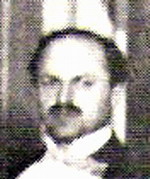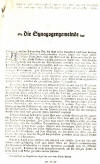
History of the Jewish Community:
This section is based on the Chapter (pages 77 to 79):
Jacob Raphael: Die Synagogengemeinde (The Jewish Community)
that was included in a festive volume published in 1924
on the occasion of the 700th Anniversary of the town of Beckum.
Also included are parts of
THE HISTORY OF THE JEWISH CONGREGATION OF BECKUM
that appeared in the “Windmueller Family Chronicle” (pages 233 to 234)
History of the Jewish Community of Beckum
The earliest reliable information on the number and the living conditions of the Jews in the town of Beckum is from the period following the 30-year war. The German Reich of those days was fragmented into mini-states and consisted of more than 300 Länder. Like everywhere else in those days, also here in Beckum the Jews existed under the immediate protection of the prevailing sovereign. In exchange for specified taxes, they were accorded security and certain privileges that had to be reaffirmed whenever a new sovereign was installed. Jews living under the protection of a ruling sovereign were called “protected Jews”.
Protection Letters of the Archbishop of Cologne as well as of Archchancellor Maximilian Heinrich of the Holy Roman Empire who also served as the Bishop of Münster, recorded the number of “protected Jews” in Beckum as three in December 1683, which is the same as under his successor, Bishop Friedrich Christian in the year 1699. The old privileges were regularly renewed. In Beckum as well as in the entire Münster region the Jews coexisted in peace with the rest of the population. Nothing is known here of any serious outbreaks of intolerance, similar to the ones that in those days frequently occurred in other regions. The decrees of the Münster diocese solemnly pledged safety and justice for the Jews of Münster.
Evidently, a Jewish community as such did not exist in those days. Only after the middle of the 18th Century could one speak of such a Jewish community. In 1743, six Jewish families resided here. In an old community book it was tersely recorded that in that same year, with great sacrifice and under difficult conditions, the construction of the first prayer house was completed. It was situated on the Nordstrasse, on the site of the present synagogue. Shortly after that, however, the number of Jewish families again dropped to five.
We learn that in the year 1767 eight Jewish families resided here. At that same time, the first mention appeared of the (subsequently well-known) family name Windmüller in an extractus protocolli dated 27 October 1767. This is especially noteworthy since other Jews at that time did not yet have family names.
The turn of the century became an epoch of historic development, with an abundance of new ideas, hopes and ambitions. Moses Mendelsohn, the Descartes of the Jews, opened new avenues for German Jewry, that finally also penetrated into the remoter regions. It is evident that the influence of this philosopher from Berlin, also reached Beckum. The desire for spiritual learning and cultural activity within the community prompted the appointment of religious leaders, rabbis, and skilled religious officials. The first groping attempts were made at educating the young generation in Jewish subjects according to pedagogic principles. Those were first attempts, because Jewish schooling was still in its early stages, and there was not yet any systematic training of teachers and educators. It was thanks to the energetic efforts of Rabbi Sutro of the Münster region that the religious affairs of the Beckum community became supervised, and compulsive religious education was initiated. He made sure that the Jewish youngsters of Beckum would have competent teachers.
The emancipation of Prussia’s Jews in 1812, inaugurated a fundamental change in the situation. The Jews of Beckum, however, were to benefit from the efforts of Baron vom Stein, only several years later. That was because in those days while Prussian statesmen prepared wars of liberation, Westphalia was was subject to the powerful regime of the Corsican conqueror. Thus the Jewish citizens of our town were to enjoy equal rights only after the collapse of the Napoleonic rule. In the year 1821 followed the official introduction of family names.
The gradual development of the private Jewish elementary school in Beckum began in the thirties of the previous century. It evolved from the former school for religious subjects. The first Jewish elementary school teacher assumed his duties for general subjects in 1835. The number of pupils and Jewish citizens of Beckum is shown in the following table:
Year Jewish citizens Pupils
1828 79 21*
1830 79 18*
1835 72 14
1840 68 12
1845 73 ?
1850 89 7
1855 87 13
(*) Religious instruction only.
The school premises were located in the synagogue building. After 1844, that same building also included the residence of the teacher. Meanwhile the community house became inadequate and a new building was being considered. At a school review by a government official from Münster in 1863, the construction changes were being examined more closely. There was the additional consideration that the Beckum Jewish community meanwhile had grown, by the addition of the communities of Lippborg, Liesborn and Herzfeld. The construction of the new community building took place in 1867. The synagogue as well as the official premises were thus considerably enlarged. Today [1924] the building has been in existence for more than half a century.
The school was considerably improved. It was
directed by dedicated teachers that were moved by the idea to create an
ambitious new generation. The longest tenure at our community was that of the
teacher Osterman who served an uninterrupted twenty year (from 1878 to 1897). Only the onset of illness
forced him to leave his position. To this day, he is a beloved
citizen of our town. His successors at the management of the Jewish
school made efforts to change its status to public. With the support
of the authorities, and after unanimous decision of the town council, the plan
was realized in 1911.
 On
1 July of that year, the first Jewish teacher was sworn in. This
public school existed for eight years. After that, it continued to function as a private school.
On
1 July of that year, the first Jewish teacher was sworn in. This
public school existed for eight years. After that, it continued to function as a private school.
During the last years of the existence of the Jewish community in Beckum, the following men held the position of Teacher and Cantor:
Sally Grunewald, Burghardt Löwenstern (See photo on Left), Adolf Tint, Willy Katz, Jacob Raphael (1924 to 1937), and finally Moritz Fuld of Butzbach.
The First World War had left its traces in our local Jewish community. Two of its members did not return from the battlefield:
Teacher Burghardt Löwenstern, born 28 March 1887 in Corbach, killed in action: 14 March 1915 in France
Julius Heine, born 12 March 1895 in Beckum, killed in action: 19 May 1916 in France
There was a memorial plaque in the synagogue in honour of these war victims. Their names are also inscribed in the war memorial of the town of Beckum.
In 1924 there were 104 Jews in Beckum.
For a List of community members during the period 1920 to 1925, Click Here
By September 1937 only 32 remained.
The cemetery of the Jewish congregation is approximately 300 years old. It is known that the cemetery was leased for the first 150 years and only then was purchased by the Jewish congregation. Around 1900 Isaac Falk - then president of the congregation - planted two rows of Elm trees on the cemetery, much against the opposition of the other two communal leaders, resulting in some discord.
The oldest resident of Beckum and probably the oldest man in Prussia was the "Schutzjude" Isaac Falk, born in Freckenhorst in 1765. He died in Beckum in 1874 and is buried on the Jewish cemetery in Beckum.
A church record dated 18 November 1769, of the Christian community in Beckum reports the baptism of the Jew Abraham Dorenbach from Holland.
The largest cement works in Beckum, "Phoenix", belonged to the children of Samuel Stein, known as "Schmudel", until their emigration in the fall of 1936. Samuel Stein had built "Schmudelsdorf" (Village of "Schmudel"). The cement works "Phoenix" on Strombergerstreet in Beckum, were under the direction of Ernst Stein, Beckum, who later lived in Berlin. In 1936 the family emigrated to the United States via Belgium and the Argentine. After the Holocaust the Stein family again came into possession of "Phoenix".
